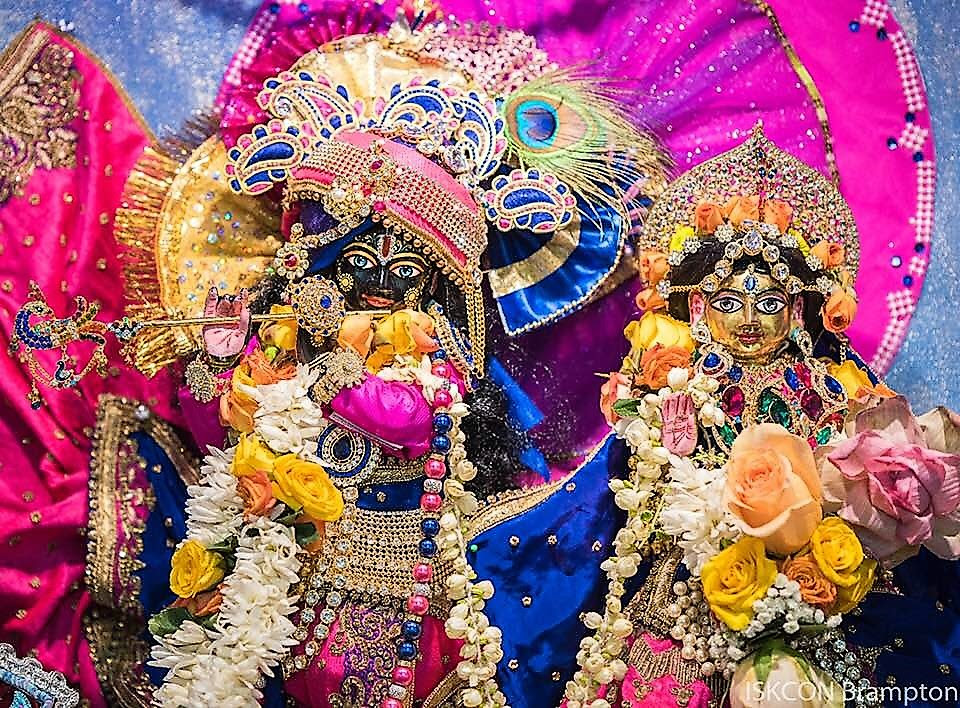Bhagavad-gita verse-by-verse podcast
The post Gita 17.03 The relationship between our existence and our faith is causal, constitutional and consequential appeared first on The Spiritual Scientist.
Websites from the ISKCON Universe
Bhagavad-gita verse-by-verse podcast
The post Gita 17.03 The relationship between our existence and our faith is causal, constitutional and consequential appeared first on The Spiritual Scientist.

(Kadamba Kanana Swami, 02 August 2017, Radhadesh, Belgium, Srimad Bhagavatam 8.4.5-6)
This Iskcon movement is a treasure box. It is sort of like a gift packet; a big gift packet full of all kinds of goodies! This movement is like that; it is just packed with mercy. None of us really have the capacity to understand Srila Prabhupada! I think that we cannot understand the mercy Prabhupada has given us. We can see some of it.
When I read the Lilamrta and I read the Prabhupada stories that the devotees tell, sometimes I think, “Yes that person describes how they perceived the transcendental nature of Prabhupada.” Then I was thinking,”All that they saw was the tip of the iceberg of Prabhupada’s mercy!” Most of an iceberg is under water. There is so much more mercy than we see. So even all the glorification of Prabhupada is only touching the tip of the iceberg. Prabhupada is so much greater; his mercy is so much greater than we can see.
Sometimes, we are thinking that we have the potential to understand. We are in a movement, and even if we have been here for like forty or fifty years it does not matter, still we cannot understand how much mercy there is. Surely we are being touched.

Sunset over the Ganga as seen from the top of the TOVP 2018 (Album with photos)
Srila Prabhupada: Narada Muni, citing a practic...

Gopi Gita: Yesterday a whole group of local community devotees volunteered at the Festival of Joy booth at the Chinese Festival at North Park Mall held by the Crow Museum. (Album of photos)
125 mandala crafts were made! 1200 Jagannath cards passed out individually to the festival and mall goers.
So many of my friends were there at different times. I came for the last two hours so I missed you all but I really wanted to express how cool it was knowing you were there and that I’m getting to share Krishna alongside you all.
Find them here: https://goo.gl/b1tNDk

2018 Navadvipa Mandala Parikrama- Day 1 (Album of photos)
“By performing Sri Navadvipa Mandala Parikrama the whole world will be liberated” -Bhaktivinod Thakur Hare Krishna! Dear Guarabhaktas, today it was the first day if the most auspicious Sri Navadvipa Mandala Parikrama. Srila Bhaktisiddhanta Sarasvati Thakur started this parikrama in 1918, thus making this, the 100th Parikrama. Sri Navadvipa Dhama ki Jay! Today the international party chanted and danced in the land of Godrumadvipa. First place visited was Suvarna Vihar. There we had Guru Puja followed by a class given by HH Bhakti Caitanya Maharaja who very expertly added Russian words to his speech, for the pleasure of the Russian devotees. Mukti Datta Prabhu is a very sweet kirtaniya from Bengal who comes every year to the International party to bathe us in the nectar of the morning bhajans: “Udilo Aruna” and “Jiva Jago”, both composed by Srila Bhaktivinoda Thakur. Next stop was Nrisimpalli where we had class by HH Bhakti Dhira Damodara Maharaja followed by a spontaneous drama of Lord Nrisimhadeva played by HG Pancharatna Prabhu and his family. The last place was Hari Hara Kshetra where the devotees will spend the night. Many have come for the first time and they are loving it. Nitai Gaura Sitanath Premanande Hari Hari Bol!
Find them here: https://goo.gl/up9D5R
The post Daily Darshan: February 18,2018 appeared first on Mayapur.com.
“By performing Sri Navadvipa Mandala Parikrama the whole world will be liberated” -Bhaktivinod Thakur Hare Krishna! Dear Guarabhaktas , today it was the first day if the most auspicious Sri Navadvipa Mandala Parikrama. After a wonderful vaishnava gathering in the Kirtan Mela, we were ready to leave the temple room and spread Krsna’s sweet names […]
The post Navadvipa Mandala Parikrama Day1 ( Feb 18th) appeared first on Mayapur.com.

“Effect of Five Offenses” lecture by Gauranga Prabhu at ISKCON Chowpatty on 18th February 2018 (video)
 This is our second reminder to kindly submit your homage to Srila Prabhupada for his Vyasa-puja book by April 15
This is our second reminder to kindly submit your homage to Srila Prabhupada for his Vyasa-puja book by April 15  Mayapur Kirtan Mela is a unique chance to chant 12 hrs a day prayerful kirtan with all devotees together.
Mayapur Kirtan Mela is a unique chance to chant 12 hrs a day prayerful kirtan with all devotees together.  I'm thrilled to have been a part of the first (and hopefully not last) Rathayatra at this festival.
I'm thrilled to have been a part of the first (and hopefully not last) Rathayatra at this festival. 
A visit to Bhaktivedanta Research Center in Kolkata (Album of photos)
Indradyumna Swami: The BRC is a project started by my go...
Bhagavad-gita verse-by-verse podcast
The post Gita 17.02 See not just people’s ideological faith – see also their functional faith appeared first on The Spiritual Scientist.
Answer Podcast
The post How can we differentiate between what to hold on to and what to let go? appeared first on The Spiritual Scientist.

The Chariot of the Mind - By the medieval poet, Govinda Das
By drinking the nectarean honey of the lotus feet of Sri Gaura, by singing the glories of Sri Gaura’s deity, by listening to the instructions of Sri Gaura, and by associating with devotees who follow his instructions, so many fortunate individuals experienced the joyous waves of prema.
—-
O mind! Why do you keep burning repeatedly in the fire of worldliness? Simply keep chanting the mantra of your dear Lord.
Think carefully about the ultimate aim of your life and then climb on the chariot of the [purified] mind. Make the feet of Lord Gaura your charioteer.
Engage your five life-airs (prāṇa, apāna, udāna, vayāna and samāna) as the five horses driving this chariot. Let āśā, the hope of attaining the Lord, be the strong rope controlling these horses so that the chariot may never break down.
Using this chariot, go quickly towards the shore of the unlimited ocean of the Lord’s loving pastimes. Having reached there, bathe thoroughly in the waves of this ocean of prema.
In this ocean, you will swim along with other servants of Hari who are delighting in the waves of bhakti-rasa. These servants of Hari will fetch you the rare jewel of prema from the depths of this ocean and will thus fulfill your most cherished desire.
In the middle of that ocean of bhakti-rasa is a house decorated with precious jewels in which brilliant complexioned Radha and dark complexioned Shyam reside.
The charioteer, Lord Gaura’s lotus feet, will help you meet these two, Radha and Shyam. It is for this reason that Govinda Das sings the glories of Gaura.

After attending the Sunday feast program in Gauradesh (Cologne) in Germany on 21 January, Kadamba Kanana Swami arrived in Radhadesh that same evening to a small group of devotees who welcomed him with a short kirtan. Maharaja spent some time with the devotees before taking rest for the night.
On Tuesday morning, Maharaja gave the Srimad Bhagavatam class. The chapter which provided the theme for the lectures that week was entitled “The Lord incarnates as Mohini-murti.” Maharaja quoted the Uddhava Gita which says that heroism means to overcome the natural tendency to enjoy material life. Maharaja discussed how to deal with the material energy and how follow this heroic path as outlined in the Nectar of Devotion – recordings to follow.
On Thursday, Maharaja gave the morning Bhagavatam class again. Continuing the descriptions of how Lord Siva was bewildered by Mohini-murti, Maharaja explained the need for the varnasrama system for dealing with the material energy when there is the affliction of lust. Later that evening saw the official opening ceremony of the Radhadesh Mellows festival with short addresses by both Sacinandana Swami and Kadamba Kanana Swami. Kadamba Kanana Maharaj spoke about how the special mercy of Lord Caitanya, Lord Nityananda and the entire Panca Tattva is unique to this Kali yuga. He explained how their special mercy in this age, helps one attain results very quickly. He also explained that the Mellows is more than just a nice festival, but rather a life-changing event which we should embrace.
 On Friday, the first day of the festival arrived and saw the unveiling of the much anticipated artwork for the festival. Fitting with the theme for this year’s festival, Lord Nityananda served as the backdrop for the Mellows this year in the form of an acrylic mural titled “Eternal Bliss” by Kardami Kapila das from Bulgaria. The first of Kadamba Kanana Maharaja’s four one-hour kirtan slots for the festival was scheduled for that morning. Even though this festival is named the “Mellows” for its meditative kirtans, true to form, Kadamba Kanana Maharaja transformed the atmosphere and got the crowd on their feet within the first ten minutes of his slot! The festival was well-organized and it meant that a strict schedule was followed for the kirtan slots each of which ended on time in a bittersweet fashion. Other legendary kirtaniyas performing included Madhava, Jahnavi Jivana and Acyuta Gopi to name just a few.
On Friday, the first day of the festival arrived and saw the unveiling of the much anticipated artwork for the festival. Fitting with the theme for this year’s festival, Lord Nityananda served as the backdrop for the Mellows this year in the form of an acrylic mural titled “Eternal Bliss” by Kardami Kapila das from Bulgaria. The first of Kadamba Kanana Maharaja’s four one-hour kirtan slots for the festival was scheduled for that morning. Even though this festival is named the “Mellows” for its meditative kirtans, true to form, Kadamba Kanana Maharaja transformed the atmosphere and got the crowd on their feet within the first ten minutes of his slot! The festival was well-organized and it meant that a strict schedule was followed for the kirtan slots each of which ended on time in a bittersweet fashion. Other legendary kirtaniyas performing included Madhava, Jahnavi Jivana and Acyuta Gopi to name just a few.
Saturday’s Srimad Bhagavatam class emphasised the importance of a retreat such as the Mellows. Maharaja discussed how such a retreat serves to strengthen our commitment and bring new life to our everyday practices. He used the Sunday morning class on Caitanya Caritamrta to discuss the glories and mercy of Lord Caitanya and Lord Nityananda which amped everyone up further for Nityananda Trayodasi the next day
 Finally, Lord Nityananda’s appearance day arrived. With a packed morning program scheduled, the day started off sweetly with Sacinandana Swami giving the morning Srimad Bhagavatam class. This was followed by a set of five entertaining short dramas directed by Syamananda Prabhu that was appreciated by all. A mesmerizing abhishek was then performed Gaura Nitai by the senior devotees present and the fun continued with pushpa-abhishek which brought out the enthusiasm in everyone. After the festivities, Kadamba Kanana Swami, Niranjana Swami and Sacinandana Swami took lunch together. Although most of the festival attendees had already begun their journeys back home, those who were still around were in for a treat with Kadamba Kanana Swami’s final kirtan offering for the festival.
Finally, Lord Nityananda’s appearance day arrived. With a packed morning program scheduled, the day started off sweetly with Sacinandana Swami giving the morning Srimad Bhagavatam class. This was followed by a set of five entertaining short dramas directed by Syamananda Prabhu that was appreciated by all. A mesmerizing abhishek was then performed Gaura Nitai by the senior devotees present and the fun continued with pushpa-abhishek which brought out the enthusiasm in everyone. After the festivities, Kadamba Kanana Swami, Niranjana Swami and Sacinandana Swami took lunch together. Although most of the festival attendees had already begun their journeys back home, those who were still around were in for a treat with Kadamba Kanana Swami’s final kirtan offering for the festival.
All through the festival, Maharaja gave his time generously to the many festival attendees and disciples who travelled from far and wide, and who eagerly awaited his association. On Tuesday, even though the Radhadesh Mellows was over, and the remaining few were set to recover from the long weekend, Maharaja gave the Srimad Bhagavatam class which continued with descriptions of the Lord in the form of Mohini-murti. Maharaja gave his experiences with the “innerer schweinehund” (the pig within). His honest descriptions and confessions were refreshing. They were well-received by the audience and appreciated for its remarkable sincerity and authenticity in dealing with this topic of lust.
On Friday, Maharaja gave one last class for the French preaching program which was attended those who were staying at guesthouse for a retreat. He then departed Radhadesh early on Saturday (3 February) morning to Germany.
Visit Flickr to see more photos.

Srimad Bhagavatam class 4.30.33 in Mayapur. Speaker: HH Devamrita Swami on 14-02-2018 (video)

Srimad Bhagavatam 4.20.13 in Mayapur. Speaker: HH Radhanath Swami, on 10-02-2018 (video)
The post Daily Darshan: February 17,2018 appeared first on Mayapur.com.

Srimad Bhagavatam class 11.5.32 and memories of Tamal Krishna Goswami in Mayapur. Speaker: HH Lokanath Swami on 16-02-2018 (video)
 By Sunanda Das
By Sunanda Das In the wake of the recent historic Chakra installation ceremony on February 7th, the TOVP is pleased to release this specialTribute song, Temple of the Vedic Planetarium, to all devotees worldwide. Written and composed by Yamuna Jivana das from South Africa, over fifty devotee singers, musicians, recording engineers and artists from all over the world contributed their talents to help create this beautiful composition in glorification of the temple, Lord Caitanya Mahaprabhu and Srila Prabhupada. The entire TOVP Team wishes to recognize and thank all the devotees who helped to make this song possible. Continue reading "TOVP Tribute Song Official Release
→ Dandavats"
In the wake of the recent historic Chakra installation ceremony on February 7th, the TOVP is pleased to release this specialTribute song, Temple of the Vedic Planetarium, to all devotees worldwide.
Written and composed by Yamuna Jivana das from South Africa, over fifty devotee singers, musicians, recording engineers and artists from all over the world contributed their talents to help create this beautiful composition in glorification of the temple, Lord Caitanya Mahaprabhu and Srila Prabhupada. The entire TOVP Team wishes to recognize and thank all the devotees who helped to make this song possible.
Use the link below to download the song, the song cover art and credits page.
Please note there are several file options of the song available in this download: high quality (lossless) — flac (Windows, Linux and Android devices) and m4a (Mac and iPhone/iPad devices), and regular (lossy) — mp3/m4a. We recommend the flac and m4a files for the best quality sound, but if your playback device doesn’t work with the flac and m4a files, the mp3 file will always work. If you are unsure which file works best with your system/device, simply download the mp3 file which can be used on all playback devices.
Become a TOVP Ambassador and share this announcement with all your friends and relatives and spread the TOVP message through music..
The post TOVP TRIBUTE SONG OFFICIAL RELEASE appeared first on Temple of the Vedic Planetarium.

Iskcon Parvat Patia Center (Surat) Rathyatra And Book Distribution Report (Album of photos)
“Our propaganda should be focused on spreading kirtana and distributing literature, books and magazines. The process experienced now is that after holding kirtana, they are selling magazines and books successfully.”
Srila Prabhupada Letter to Brahmananda, 30th January 1969

Visit to Santipura (Album with photos)
Indradyumna Swami: Yesterday we took a large group of devotees to Santipura. There in th...
 By Vaishnava Das
By Vaishnava Das Govardhan Ecovillage hosted a 4-day conference, Hinduism and Ecology: Towards a Sustainable Future, from 11th to 14th of December 2017. The conference was jointly organized by Yale University, Govardhan Eco Village, Bhaktivedanta Vidyapith, and Maharashtra Tourism, and brought together leading faculty from prominent American universities and Hindu leaders from around the world, who extensively explored Vedic solutions to the ecological crisis. Continue reading "Hinduism and Ecology: Towards a Sustainable Future
→ Dandavats"
 By Mayapur Sasi dasa
By Mayapur Sasi dasa For the pleasure of Srila Prabhupada this report contains the following North American results of book distribution for the month of January 2018. North American Totals, Monthly Temples, Monthly Weekend Warriors. Monthly Top 100 Individuals, Monthly Top 5, Cumulative Countries, Cumulative Temples, Cumulative Top 100 Individuals, Cumulative Top 5 Continue reading "NASN January 2018 – North American Sankirtan Newsletter
→ Dandavats"
Bhagavad-gita verse-by-verse podcast
The post Gita 17.01 The Gita universalizes and contextualizes the analytical framework of the three modes appeared first on The Spiritual Scientist.
Answer Podcast
The post When we feel excessive fear, how can we correct the mind’s corrupted software? appeared first on The Spiritual Scientist.

| ||||||||||||||||||||||||

 Today is Srila Jagannatha dasaBabaji Maharaja’s disappearance day. He comes in the Gaudiya Vaishnava disciplic succession after Srila Visvanatha Cakravarti Thakura and Srila Baladeva Vidyabhusana. He was a renounced ascetic, fully engaged in chanting the holy names of Krishna and meditating on His pastimes. For some time, he made his residence at Surya-kunda in Vraja-dhama, near the temple of Suryadeva, where Srimati Radharani used to come and worship the sun-god—or, I should say,where She used to come to meet Krishna on the pretext of coming to worship the sun-god.
Today is Srila Jagannatha dasaBabaji Maharaja’s disappearance day. He comes in the Gaudiya Vaishnava disciplic succession after Srila Visvanatha Cakravarti Thakura and Srila Baladeva Vidyabhusana. He was a renounced ascetic, fully engaged in chanting the holy names of Krishna and meditating on His pastimes. For some time, he made his residence at Surya-kunda in Vraja-dhama, near the temple of Suryadeva, where Srimati Radharani used to come and worship the sun-god—or, I should say,where She used to come to meet Krishna on the pretext of coming to worship the sun-god.
Srila Bhaktivinoda Thakura, who comes in the disciplic succession after Jagannatha dasa Babaji, accepted Srila Jagannatha dasa Babaji Maharaja as his main guru, his siksa-guru. Once, some of Jagannatha dasa Babaji’s disciples in Vraja approached the Thakura. They complained that although they had come to Vraja to live like Jagannatha dasa Babaji, fully absorbed in chanting the holy names and meditating on Sri Sri Radha-Krishna’s astakaliya-lila, Babaji Maharaja had refused to instruct them in such esoteric topics and had instead engaged them in cultivating tulasi plants, flowers, and vegetables to offer to the Lord. So, these disciples requested Bhaktivinoda Thakura to appeal to their guru maharaja to instruct them in the esoteric practices of Krishna consciousness.
Srila Bhaktivinoda Thakura told them, “Actually, your gurudeva’s instructions are right for you. Because you still have anarthas, for you to try to sit and do nirjana-bhajana [solitary worship] and practice asta-kaliya-lila-smarana [meditation on the Lord’s eightfold daily pastimes] would be artificial, and you would just become degraded. So you should follow your gurudeva’s instructions with full faith and work hard in Krishna’s service. Then, in time, you may be able to chant the holy names purely.”
Eventually, Jagannatha dasa Babaji moved to Mayapur, where he lived by the banks of the Ganges, fully absorbed in chanting the holy names. He had the greatest reverence for the holy land of Navadvipa. Although he was so renounced and so absorbed in Krishna consciousness, as his reputation spread, gentlemen would come to him and give him donations. Once, Babaji Maharaja asked one of his servants to take the donations he had received, which he kept in an old burlap bag, and purchase a large pot of rasagullas. All the devotees were surprised, because Jagannatha dasa Babaji was so renounced and lived so simply. He would eat just the most simple rice and dal. Anyway, the servant brought the sweets, and Jagannatha dasa Babaji offered them to his Deities and then distributed them to the cows and dogs in the dhama. He said that the creatures of the dhama were elevated souls and worthy of service.
Later, Babaji Maharaja would not accept prasada until he had shared his food with ten newborn puppies. He would wait until they came, and he would count them with his hands. In his old age, Babaji Maharaja’s eyelids drooped over his eyes and prevented him from seeing. So he would count them with his hands, and only after they had begun to eat would he also partake. He would say, “They are puppies of the dhama. They are not ordinary living entities.”
He had so much faith in and affection for the dhama.
He had less affection for Mayavadi impersonalists. He used to say, “Let the dogs come in for darsana, but the impersonalists—kick them out!”
Srila Jagannatha dasa Babaji lived to a very old age. In fact, some Vaishnavas say he was just waiting for Srila Bhaktivinoda Thakura to come—someone to whom he could impart his special knowledge and realization, for the benefit of humanity. Srila Bhaktivinoda Thakura had requested to be transferred from his post in Orissa to Bengal so he could be near Navadvipa-dhama. And eventually, he was posted at Krishnanagar, near Navadvipa.
Srila Bhaktivinoda Thakura did extensive research to determine the actual birthplace of Sri Chaitanya Mahaprabhu. He studied various old maps, consulted the local people, and visited the different places. Eventually he found a mound where many tulasi trees were growing. He got the intuition that this was the actual birthplace of Lord Chaitanya, but he wanted his intuition to be confirmed. At the time, Jagannatha dasa Babaji was the most renowned Vaishnava, and he was Srila Bhaktivinoda Thakura’s siksa-guru. Thus, Jagannatha dasa Babaji’s disciples carried him to the place where the mound and tulasi plants were situated. He was so old (over a hundred and forty years old, some say) that his disciples had to carry him in a basket. And his eyelids were so heavy that he had to open them with his hands to be able to see. So, the disciples brought him, but they didn’t tell him that it was the site Bhaktivinoda Thakura had determined to be the birthplace. Still, when Babaji Maharaja arrived there, he spontaneously jumped out of his basket and began to dance in ecstasy, singing the holy names. Thus he confirmed the location of Mahaprabhu’s birthplace.
Srila Jagannatha dasa Babaji’s bhajana-kutira and samadhi are there in Navadvipa-dhama, in Koladvipa. Devotees who perform Navadvipa-parikrama visit there and get his mercy. We also pray to him for his mercy, that we may be instrumental in fulfilling the desires of Srila Bhaktivinoda Thakura, Srila Gaurakisora dasa Babaji Maharaja, Srila Bhaktisiddhanta Sarasvati Thakura, and the other acaryas in the line of Sri Chaitanya Mahaprabhu coming to us through Srila Prabhupada and his disciples.
Srila Jagannatha dasa Babaji Maharaja ki jaya!
Srila Prabhupada ki jaya!
Today we also think of His Holiness Tamal Krishna Goswami Maharaja, who left this world on Jagannatha Dasa Babaji’s disappearance day, also in Gauda-mandala-bhumi.
Two years ago I was in Dallas for the disappearance day of Srila Bhaktivinoda Thakura, just a few months after Goswami Maharaja passed away. As we were observing the ceremony in the temple, I was thinking how Tamal Krishna Goswami was the perfect servant and therefore the fit representative of Srila Bhaktivinoda Thakura. Then I thought of him in relation to all of the acaryas in the last two centuries—Srila Bhaktivinoda Thakura, Srila Bhaktisiddhanta Sarasvati Thakura, and Srila Prabhupada (who are the most prominent of them)—and how he really took their mission to heart. He was absorbed in fulfilling all aspects of their mission: developing Mayapur, distributing books, spreading the chanting of the holy names throughout the world in various ways—all the programs that were so important to our predecessor acaryas.
Although I could speak of Goswami Maharaja’s surrender and service for days, we now have the rare opportunity to hear from His Grace Amoghalila dasa Adhikari.
Amoghalila dasa:
nama om visnu-padaya krsna-presthaya bhu-tale
srimate bhaktivedanta-svamin iti namine
namas te sarasvate-deve gaura-vani-pracarine
nirvisesa-sunyavadi-pascatya-desa-tarine
vancha-kalpa-tarubhyas ca krpa-sindhubhya eva ca
patitanam pavanebhyo vaisnavebhyo namo namah
I am thinking of one or two incidents I can mention, and some realizations I had from them. One was the last morning Srila Prabhupada was in Bombay, in Juhu. I was fortunate—actually by Giriraj Maharaja’s mercy—to be able to be in Srila Prabhupada’s room then. After about a month in Bombay, Srila Prabhupada was leaving that morning for Vrindavan. Madhava Prabhu and Upendra Prabhu were also there, though Upendra was in and out of the room.
Srila Prabhupada was just lying on his bed. He could hardly move. He couldn’t even sit up by himself. He was so weak he could barely speak. But then he said something. It was hard to hear what he said, so I leaned near him and asked, “What, Srila Prabhupada?” He said, “Call Tamal.” So Upendra Prabhu went out to get Tamal Krishna Maharaja. When Goswami Maharaja came into the room, Prabhupada’s bedroom, he offered dandavat-pranama (prostrated obeisances), and then he got up. Srila Prabhupada asked him about the arrangements for going to Vrindavan. Goswami Maharaja said, “Yes, Srila Prabhupada,” he offered dandavat-pranama, and he went out. A minute or two later he came back in. He offered dandavat-pranama, he got up, and then he told Srila Prabhupada the answer to Prabhupada’s question. He said something, he got something ready, and then he offered dandavat-pranama and went out. This happened at least three times: He came in and went out, he came in and went out, he came in and went out within just a few minutes—it couldn’t have been more than five minutes. Practically every minute he was coming in, offering dandavat-pranama, getting up, talking to Prabhupada for a few seconds or half a minute, offering dandavat-pranama again, and going out.
Later,after Srila Prabhupada left us, when I was Goswami Maharaja’s personal secretary, I mentioned this to him. He said, “Yes, Srila Prabhupada instructed me to do this. Srila Prabhupada said that because familiarity breeds contempt, it is very important when
somebody is intimately serving the spiritual master that they keep a reverential mood.” Goswami Maharaja, of course, was such an intimate servant of Srila Prabhupada’s, yet he always maintained that deep reverence—of course love, also, but at the same time he always had such deep reverence for Srila Prabhupada. Tamal Krishna Maharaja is such an ideal example of a personal servant and disciple.
I am thinking of one other incident then, when I was Goswami Maharaja’s personal secretary in 1978 in Bombay. As I mentioned to Giriraj Maharaja, I think the real reason Goswami Maharaja wanted me to be his personal secretary was so he could train me, because he had seen how disturbing my mismanagement was. I had been the vice president and the so-called manager of Hare Krishna Land, and at one point during that time, Giriraj Maharaja had mentioned to Tamal Krishna Maharaja, “Amoghalila is mismanaging the affairs here.” Goswami Maharaja had said, “There is no mismanagement . . . There is no management!” So, he felt that I needed some training in management. Therefore, he made me his personal secretary, to train me. I think that was the main reason, and he tried to train me and he did.
He did train me a lot, although I didn’t follow his training so well, but one incident when he trained me was very moving. Every time I think about it, I just . . . He was teaching me how to clean the floor. I mean, I had been a devotee for six or seven years, so I had been cleaning floors for a long time. Anyway, once when I was cleaning the floor, he said, “No, that’s not how you clean the floor,” because I had the cloth bunched up or something. So, he took the cloth from me, he got down on his hands and knees, he spread the cloth out big, he folded it over once, I think just once, and he started cleaning the floor. I tried to stop him; I said, “Maharaja, it’s okay, it’s okay. I’ll do it.” He responded, “No, I want to show you how to do it.” And he cleaned for quite a while. He cleaned a large area, and I was protesting, but he said, “No. Just watch what I am doing.” He had the cloth spread out quite big, and he cleaned for some time. I tried to stop him again, but he explained: “No, Srila Prabhupada did this to me. Srila Prabhupada showed me like this. He got down on his hands and knees and he cleaned the floor to show me how to do it. So why can’t you let me show you how to do it?”
So, Tamal Krishna Goswami was the perfect servant of Srila Prabhupada. As you said, Maharaja, the perfect servant or ideal servant becomes the ideal representative. Goswami Maharaja was so strict in following Srila Prabhupada, exactly to the detail—even how you open up a cloth and fold it and clean the floor, every detail, everything!
Hare Krishna.
Giriraj Swami: When you began, saying how Tamal Krishna Goswami would come and offer full obeisances, I thought of what some devotees told me about his routine in Dallas after Srila Prabhupada left. Every night he would go into Prabhupada’s room where the deity of Prabhupada was installed, and he would chant his last Gayatri and put Prabhupada to rest. He wanted to do that as his personal service. And they told me that whenever Goswami Maharaja would leave the temple premises, even for an hour or two, he would first circumambulate the building. They gave me the impression that he was circumambulating Srila Prabhupada, although, of course, he was circumambulating the other deities as well. But he was very conscious of Srila Prabhupada. In general, he was always very conscious of his lords and masters.
I also think of how Goswami Maharaja had one of Srila Prabhupada’s teeth, which he placed in a silver capsule and hung around his neck. Indradyumna Swami, who is quite expert in getting deities and sacred relics, once was asking Tamal Krishna Goswami questions about the tooth—what was eventually going to happen to it. And Tamal Krishna Goswami understood that Indradyumna Maharaja was trying to see if he could one day get the tooth. Goswami Maharaja just laughed and said, “Don’t even think of it. I am taking it with me. Even after I leave, it will stay with my body.’ And it did. His idea was that by the tooth being put into his samadhi, people who circumambulated his samadhi or offered obeisances there would get the benefit of circumambulating Srila Prabhupada’s tooth, of offering obeisances to his tooth. And on the absolute platform, Srila Prabhupada’s tooth is as worshipable as he is.
Hare Krishna!
[Talks given on February 20, 2004, in Carpinteria, California]